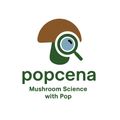🍄🌧️ The Science of Mushrooms After Floods — Episode 1
“When Nature Reawakens”
(Popcena Studio Series: Mushrooms After the Flood)
เพราะเมื่อดินกลับมาได้รับอากาศอีกครั้ง
“เส้นใยเห็ด” ที่ซ่อนอยู่ใต้ผิวดิน ได้รับสัญญาณให้ตื่นขึ้น —
มันคือการรับรู้ถึงการเปลี่ยนแปลงของ ออกซิเจน (O₂), คาร์บอนไดออกไซด์ (CO₂) และ ความชื้น
ที่บอกว่า “ถึงเวลาสร้างชีวิตรุ่นต่อไป”
ในสภาวะน้ำท่วม ดินจะขาดอากาศ (anaerobic)
เส้นใยเห็ดหยุดเจริญและพักตัวไว้
แต่เมื่อระดับน้ำลดลง ดินเริ่มหายใจอีกครั้ง
พลังงานจากอินทรียวัตถุที่หมักไว้จึงกลายเป็นอาหารอุดมสมบูรณ์
เห็ดหลายชนิด เช่น
🌾 เห็ดฟาง (Volvariella volvacea),
🌳 เห็ดโคน (Termitomyces spp.),
🍂 เห็ดขอน (Pleurotus spp.)
ใช้จังหวะนี้เพื่อ “ผลิดอกพร้อมกัน” — เหมือนการเฉลิมฉลองการฟื้นตัวของธรรมชาติ
ธรรมชาติรู้วิธีฟื้นตัวเสมอ...
แม้หลังจากน้ำจะท่วมสูงเพียงใดก็ตาม 🌏
---
English Version (for bilingual caption / LinkedIn / Facebook bilingual format):
After a flood, when the land breathes again,
you might notice mushrooms bursting from the wet soil —
a natural miracle, but one deeply scientific. 🍄
During floods, fungal mycelium lies dormant underground.
When the water recedes, oxygen returns, CO₂ levels shift,
and humidity rises — all signals telling fungi:
“Now is the time to fruit.”
Decomposing organic matter becomes abundant nutrition.
Species like Volvariella volvacea, Termitomyces, and Pleurotus
respond rapidly, forming fruiting bodies almost overnight.
Nature has its own rhythm of recovery —
and mushrooms are its quiet messengers of renewal. 🌿
👉เคยสังเกตไหมคะว่า หลังน้ำลด เห็ดมักขึ้นเต็มพื้นดิน?
แล้วในพื้นที่ของคุณ...มี “เห็ดหลังน้ำท่วม” ชนิดใดบ้าง? 🌧️🍄
👉 Have you ever noticed mushrooms sprouting everywhere after floods?
What kinds of post-flood mushrooms appear in your area? 🌧️🍄
“When Nature Reawakens”
(Popcena Studio Series: Mushrooms After the Flood)
1. Chang, S. T., & Miles, P. G. (2004). Mushrooms: Cultivation, nutritional value, medicinal effect, and environmental impact (2nd ed.). CRC Press.
2. Kirk, T. K., & Farrell, R. L. (1987). Enzymatic “combustion”: The microbial degradation of lignin. Annual Review of Microbiology, 41(1), 465–505.
3. Moore, D., Robson, G. D., & Trinci, A. P. J. (2008). 21st Century Guidebook to Fungi. Cambridge University Press.
4. Pointing, S. B. (2001). Feasibility of bioremediation by white-rot fungi. Applied Microbiology and Biotechnology, 57(1–2), 20–33.
5. Tibuhwa, D. D. (2013). Termitomyces species diversity and their contribution to household food security and income in sub-Saharan Africa. International Journal of Microbiology and Mycology, 1(1), 1–14.
6. Royse, D. J. (1996). Influence of spawn rate and environmental factors on mushroom yield. Applied Microbiology and Biotechnology, 46(4), 524–528.
#PopcenaStudio #MushroomScience #AfterTheFlood #FungalEcology #Sustainability #Biodiversity #ScienceWithPop #ThaiBiodiversity
- 5
ดูเพิ่มเติมในซีรีส์
โฆษณา
- ดาวน์โหลดแอปพลิเคชัน
- © 2025 Blockdit


